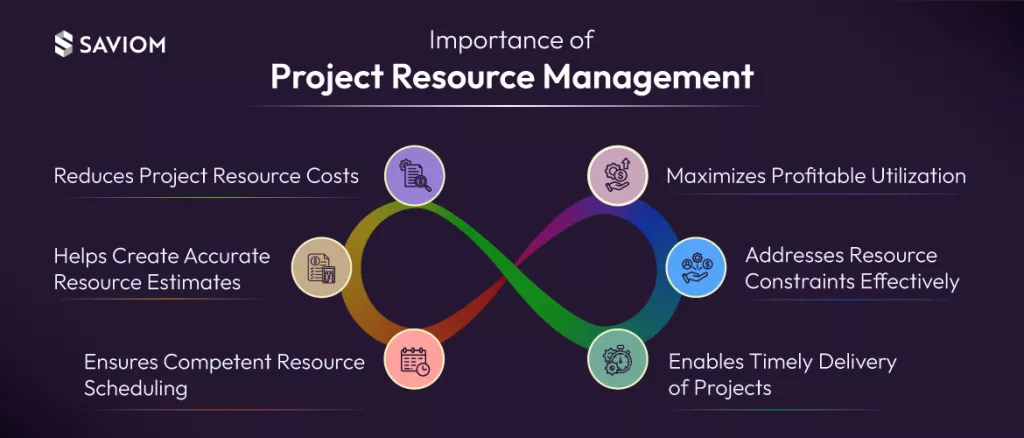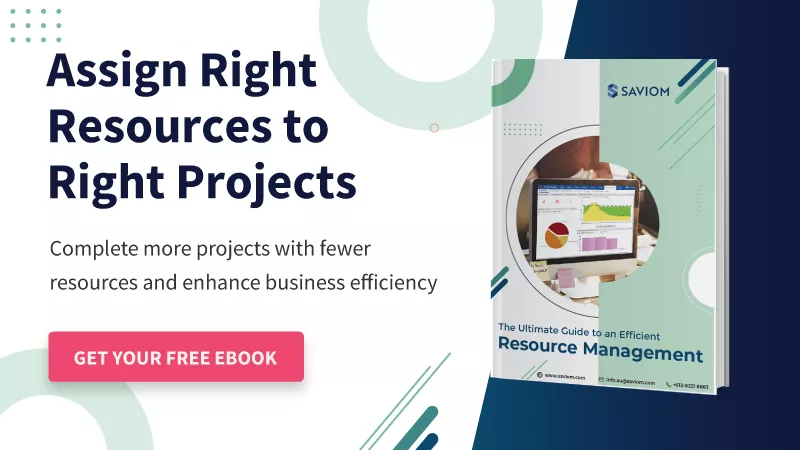Are you having difficulty ensuring the right resources are assigned to the right project tasks?
Do you find it hard to keep track of resource costs and stay within the project budget?
Is it challenging to monitor and track resource utilization throughout the project lifecycle?
Project resource management is the strategic approach that empowers managers to navigate these challenges. It encompasses the allocation, utilization, and optimization of resources to achieve project objectives within specified constraints, ensuring successful delivery.
However, unforeseen circumstances can sometimes create a resource crunch that adversely affects project delivery.
For instance, what if key team members fall ill, take a sabbatical, or change jobs unexpectedly? In such a scenario, project managers must have a backup plan to ensure that the remaining resources are not overloaded, disengaged, or unproductive in their tasks.
This article aims to cover the essential aspects of project resource management, including a step-by-step guide to creating an effective project resource plan.
But before delving deeper, let us begin with the project resource management definition.
What is Project Resource Management?
Project resource management is the process of planning, forecasting, scheduling, utilizing, and optimizing resources required to complete a project successfully. It ensures that the right resources are allocated to the right task and are used efficiently throughout the project lifecycle.
Moreover, effective project resource planning helps managers visualize under/over-utilized resources or those getting rolled off from tasks and re-allocate them to suitable project vacancies. As a result, it helps project managers measure every team member’s productivity and take proactive steps to maximize billable utilization.
Smart project resource management enables you to answer questions like:
- Do I have sufficient resources to finish a job?
- Or do I need to hire someone else?
- How can I reduce project resource costs and complete the delivery?
Therefore, project resource management is a continuous process, and by implementing it, one can meet the overall objectives, improve the project outcomes, and boost ROI.
Now that we know what is project resource management, let’s understand it in greater detail through an example.
Project Resource Management Example
An IT firm has a new mobile app development project in the pipeline. So, the project manager begins by creating a Work Breakdown Structure (WBS) and defines the tasks for each project phase, including:
- Requirement analysis
- App design
- Front-end development
- Back-end development
- Testing & deployment
- Post-deployment support
Next, the project manager develops a Resource Breakdown Structure (RBS) to forecast the resources required, which include:
- Five mobile developers proficient in Swift and Kotlin
- Two QA testers
- Two UI/UX designers skilled in Sketch
- Two DevOps engineers with Google Cloud Platform (GCP) expertise
Upon determining the requirements, the project manager requests resources for all these roles to the resource manager.
The resource manager then starts the resource identification and allocation process. They look into the internal resource database to identify employees with the appropriate skills and competencies for each role. They also assess the availability and capacity of these resources for the specified time frame. Once the required resources are identified, they are allocated to the project.
The project manager then assigns these resources to the appropriate project tasks based on their expertise, ensuring the project starts on time. As the project progresses, the manager tracks KPIs such as on-time task completion and budget adherence. They also optimize resource utilization to maintain productivity.
Thus, by proactively managing project resources and preparing for unforeseen challenges, the objectives are achieved on time and within quality standards, ensuring successful completion.
Now that we understand project resource management, let’s understand different processes it encompasses.
Project Resource Management Processes
There are 4 steps to efficiently manage resources in project management. Let’s understand them in detail.
Resource Planning
Resource planning is the foundational step in the project resource management process. It includes creating a comprehensive plan that clearly defines the resource requirements for the entire project lifecycle. In this step, project managers can use top-down or bottom-up estimation techniques to identify the type, quality, number, and timeline of resources needed to meet the final deliverables.
They also define the roles and responsibilities of every project team member. Additionally, the resource plan outlines the specific actions managers would take when they encounter resource risks such as skill shortage, sub-optimal utilization, burnout, attrition, etc.
Resource Allocation and Scheduling
Once project managers have established the overall talent requirement, the next step is resource allocation and scheduling. Here, resource managers are responsible for gathering project demand and identifying competent resources from the internal pool who match the skill requirements. Based on the availability of resources, they would assign the best-fit personnel to the project.
Then, the project manager would schedule these resources for specific tasks and activities based on their skills, expertise, and interests. Moreover, in case of talent shortages, managers must take corrective measures such as hiring permanent or contingent workers and out-rotation and backfilling to bridge the gap. These measures help keep the project schedule on track and ensure timely delivery.
Read More: What is Resource Allocation, and Why is it Important?
Team Development and Management
Team development is a critical part of an effective project management process. This step helps managers to create a competent project team through comprehensive training and development initiatives. It enables them to provide on-the-job, mentoring, or shadowing opportunities to boost the competencies of the team members and prepare them for upcoming work.
Project team development and management also focuses on creating a conducive work environment that facilitates seamless collaboration between project resources and ensures high productivity. Moreover, project managers provide timely feedback and recognition to boost team morale and performance.
Continuous Evaluation and Resource Optimization
Continuous evaluation and resource optimization are critical to ensure the project team is working productively to complete tasks and milestones on time, resulting in successful delivery. Project managers must regularly monitor and track team utilization to identify and address under or overloading, preventing instances of burnout or disengagement.
Depending on the project type, they can implement resource leveling and smoothing techniques to balance team workload. Furthermore, managers must continuously monitor other project metrics such as time, budget, and constraints and take course-corrective actions to prevent the project from derailing.
Read More: How Resource Optimization Boosts Task Management?
Now that we know the different project management processes, let’s understand the significance of managing resources in projects.
Importance of Project Resource Management
An effective project resource management strategy improves a team’s performance, engagement, and productivity. It also aims to meet delivery commitments and client satisfaction. Let’s understand the benefits in detail.
Reduces Project Resource Costs
An effective resource management process provides complete visibility of the workforce across the enterprise. This helps them leverage local and global resources from low-cost locations. As a result, managers can substantially reduce project costs without compromising quality. It also helps avoid deploying under-skilled or over-skilled resources in a project.
Read More: 5 Ways to Reduce Project Management Costs
Helps in Accurate Resource Estimation
Accurate resource estimates are essential for effective project planning and budgeting. By thoroughly analyzing project requirements, managers can make precise estimates regarding the type, quantity, and quality of resources needed to start the project. This leads to more realistic project plans and prevents the risk of resource shortages or excesses during project execution.
Maximizes Profitable Utilization
Project managers can forecast and improve billable and strategic resource utilization and ensure that all resources are used to their full potential without being overworked. This helps balance the workload, prevent burnout, and maintain productivity. It also leads to better project performance and higher profitability as resources are effectively used to generate maximum value.
Read More: How to Track Resource Utilization?
Ensures Competent Resource Allocation
As mentioned above, an effective project resource management plan equips project managers with a comprehensive view of resources. This allows them to get a clear picture of key attributes like skillsets and employee preferences, their schedules and availability, etc. As a result, they can ensure competent resource allocation and improve productivity.
Addresses Resource Constraints Effectively
Resource constraints, such as limited availability of skilled personnel or critical equipment, can significantly impact project progress. Effective resource management involves identifying these constraints early and developing strategies to mitigate them. This can include cross-training employees, outsourcing tasks, or adjusting project timelines to ensure smooth execution.
Read More: What are Resource Constraints, and How Does It Affect Project Success?
Facilitates Timely Delivery of Projects
Effective resource management ensures that resources are available and scheduled appropriately, reducing delays and ensuring project milestones are met. By managing resources efficiently, project managers can ensure that projects are completed on time, enhancing client satisfaction and ROI.

Now, let’s explore the different tools used for project resource management.
Effective Project Resource Management Tools
Kanban Board
Kanban board is a project management tool that enables managers to track the progress of different tasks and visualize the workflow. It uses elements such as cards, columns, work in progress (WIP) limits, commitment points, and delivery points to represent different stages of the workflow, such as “To Do,” “In Progress,” and “Done.”
Key Benefits:
- Provides an at-a-glance overview of the project’s status, making it easier to review and improve processes to streamline workflow and reduce overhead.
- Adapts easily to different projects and team structures.
- Helps team understand how work is processed by mapping all the stages of the work process.
- Highlights bottlenecks, which allows teams to address issues promptly and improve efficiency.
- Prevents resource overloading with WIP limits.
Gantt Chart
Gantt chart is a visual representation of the project schedule. It uses a bar chart format to show the start and end dates of project tasks, their durations, dependencies, and progress. Gantt charts are typically useful for planning, scheduling, and tracking projects with interconnected tasks and milestones.
Key Benefits:
- Breaks down complex projects into manageable tasks, sub-tasks, and work packages.
- Provides clear visibility of task dependencies, preventing scheduling conflicts and talent shortages.
- Ensure resources are allocated appropriately across all project activities.
- Enables project tracking by allowing users to monitor resource utilization, task dependencies, milestones, and other metrics.
- Keeps teams aware of critical deadlines and milestones.
Backlogs
A backlog is a list of tasks, features, or requirements that must be completed in a project. It is commonly used in agile projects to organize tasks in order of priority for future sprints or iterations. It includes elements such as enhancements, bug fixes, user stories, product releases, etc. There are different types of backlogs, such as product, sprint, team, and release, each serving a unique purpose to ensure work is organized and aligned with broader objectives.
Key Benefits:
- Helps teams focus on high-value tasks by providing a prioritized list of work items.
- Allows for quick adjustments based on changing requirements or priorities.
- Facilitates better resource allocation, thereby reducing overhead costs and ensuring timely delivery.
- Provides visibility to all stakeholders on the work to be done and the current status.
- Encourages discussions around task priorities, dependencies, and potential issues, reducing confusion and ambiguity.
Resource Breakdown Structure
Resource Breakdown Structure is a hierarchical composition of resources, human and non-human, required to complete a project. It is typically broken down by function and type, which allows managers to plan, allocate, and track resources more effectively throughout the project lifecycle.
Key Benefits
- Provide a clear overview of resource requirements in every project phase, facilitating competent allocation.
- Enables better forecasting of resource requirements, preventing capacity excess or shortages.
- Prevents budget escalations by helping managers create a cost-effective project resource mix.
- Helps identify potential resource constraints and risks early in the project.
- Provides stakeholders with a clear view of the resources needed and allocated throughout the project.
Next, let’s understand the significant challenges in project resource management.
Challenges in Project Resource Management
Planning, allocating, monitoring, and implementing control measures for successful delivery can be challenging without the right tools. Some of the significant challenges of managing resources in project management are:
Inaccurate Project Resource Estimation
Without proper tools and techniques, organizations rely on approximation and guesswork to forecast and estimate project resource requirements. This practice often leads to inaccurate estimations. When resources are underestimated, project teams may find themselves overburdened, resulting in stress and reduced productivity.
Conversely, overestimating resources can lead to excess team members being idle, which can cause billable losses. Thus, improper resource estimation can lead to project delays and budget overruns, resulting in client dissatisfaction.
Read More: Understanding Resource Availability Within Project Management
Unorganized Resource Requisition Workflow
Organizations that rely on manual resource requisition fail to track project resource requests effectively. In such a scenario, resource managers work on a ‘first-come, first-served’ basis for allocations and sometimes assign resources to low-value projects, leaving critical projects inadequately staffed.
Further, multiple requests via disparate channels, like emails, calls, messages, etc., cause communication silos between the resource and project manager. Consequently, resource managers may allocate the same resources to multiple projects for the same timeline, leading to resource scheduling conflicts and double bookings.
Sub-Optimal Utilization of Project Resources
One of the biggest challenges of project resource management is maximizing billable or strategic utilization without overloading the resources. Often, project managers assign more tasks to a few employees because they have been counted upon in the past to deliver results.
This overloading can lead to stress and burnout and build animosity among team members. Furthermore, it can lead to delays and budget overruns due to the unavailability of essential resources. On the other hand, underutilization of resources can cause disengagement and lower productivity. Both instances lead to poor project outcomes.
Read More: What is Resource Utilization? A Complete Guide to Improve Business Efficiency
Incompetent Resource Allocation
Allocating suitable resources to the right task is critical for successful project delivery. However, if organizations rely on spreadsheets to allocate resources, it creates silos of data. Thus, it becomes challenging for managers to assess which resource is working on what tasks, thereby leading to overallocation and resource unavailability.
Additionally, outdated legacy tools lack the mechanism to capture, track, and update resource skills and competencies. This makes it difficult for managers to identify and assign the best-fit personnel to every project task. Such instances of skill mismatches can lead to project budget escalation and sub-par deliverable quality.
Sudden Ramp-Up & Ramp-Down of Resources
Managing the sudden ramp-up/ramp-down of resources presents a significant challenge in project resource management. Ramp-ups occur when project demands unexpectedly escalate, requiring quick mobilization of additional resources to meet deadlines.
Conversely, ramp-downs happen when project activities are done, leading to the release of resources. They end up on the bench, which reduces their billability and lowers their morale. Failure to manage these demand fluctuations can lead to last-minute firefighting, increased bench size, and revenue losses.
Read More: How to Balance Ramp-Ups and Ramp-Downs in a Project?
Disconnect Between Sales and Delivery Team
In a project-based business, miscommunication between the sales and delivery teams can spiral down your projects, resulting in low client satisfaction. Once the sales team wins an opportunity, the delivery team takes ownership and is responsible for adhering to the commitment.
However, while achieving the sales targets, the sales team sometimes fails to involve the delivery team before signing the deal and understanding whether there are sufficient personnel to undertake the project. As a result, the delivery team struggles with eleventh-hour resource allocations to meet the deliverables.
Now that we understand the various challenges, let’s learn the steps to develop a robust project resource management plan.
Steps to Create a Project Resource Management Plan
Enlisted below is a step-by-step approach to create a well-defined project resource management plan.
Define the Scope of Work
The first step in creating a project resource management plan is to define the scope of work. This involves identifying the project’s objectives, deliverables, and tasks that need to be accomplished. By identifying what needs to be done, project managers can accurately determine the types of resources—such as personnel, materials, and equipment—that will be required for successful completion.
Create a Resource Breakdown Structure (RBS)
Once the project scope is defined, the next step is to create a Resource Breakdown Structure (RBS). Here, the project manager will breakdown the assignment into manageable tasks, sub-tasks, and work packages, and determine the number and type of resources needed for each of these activities. They will further assess the expertise level and timeline for which these resources will be needed.
Read More: What is Resource Breakdown Structure & Its Significance?
Assign Resources to Project Tasks
In the following step, the project and resource manager will collaborate to identify and assign the best-fit resources to specific tasks. This involves looking into the internal and external channels to select appropriate staff who meet the project’s skill requirements. Furthermore, managers must consider the availability and interests of the resources when allocating them to the project tasks.
Identify Resource Constraints
Next, the project manager must take account of all resource constraints such as unplanned absenteeism, attrition, burnout, underutilization, etc. They must create a risk matrix to assess the likelihood and impact of these potential risks. They can further categorize the risks into critical, major, moderate, minor, etc., based on their severity. Moreover, they can assign a risk owner who will be responsible for monitoring and controlling each constraint.
Develop Resource Risk Mitigation Strategies
After the resource constraints have been established, managers must develop appropriate mitigation strategies for every identified risk. A proper mitigation plan helps reduce the impact of these issues on the overall project schedule and outcome. Moreover, managers must continuously track, review, and optimize the plan to ensure the effectiveness of the risk response and contingency plans.
Read More: What Are Resource Risks in Project Management & How to Mitigate Them?
Establish KPIs to Monitor Progress and Performance
Next, managers must establish Key Performance Indicators (KPIs) to monitor the progress and performance of the project resources. Some common KPIs to consider include utilization rates, billable vs. non-billable hours, forecasted vs. actual time spent, and on-time completion percentage. By regularly monitoring these metrics, managers can identify deviations and take corrective actions to keep the project on schedule.
Seek Approval from the Project Stakeholders
The final step is to compile the aforementioned information into a plan and present it to project stakeholders, including clients, senior management, or department heads. Managers must seek their approval and feedback. This ensures consensus among involved parties regarding key project parameters such as resources, timeline, budget, and constraints. Therefore, obtaining stakeholder buy-in helps validate project feasibility and ensure successful delivery.
Read More: Who are Project Stakeholders, and How to Manage Them Efficiently?
Now that we have learned the steps to create a project resource management plan, let’s understand the best practices.
Project Resource Management Best Practices
Listed below are some of the proven practices to improve project resource management:
Track and Optimize Resource Schedules as Appropriate
Monitoring current and future resource schedules enables project managers to identify bottlenecks such as double booking, over/under-allocation, etc. It provides them sufficient lead time to adjust project timelines, add more resources, or initiate staggered hiring to address resourcing bottlenecks.
Moreover, project managers can apply resource leveling and smoothing to prevent instances of overutilization and employee burnout. On the contrary, in case of underutilization, they can initiate training activities or assign them more work.
Read More: What is Resource Scheduling? How to Schedule Resources for Projects Efficiently?
Keep a Resource Buffer
Maintaining a resource buffer is an essential best practice that helps protect the project schedule from unforeseen events such as unplanned absenteeism or attrition. It ensures that resources required to complete critical tasks are available when needed. For this, managers must identify the critical roles and tasks within the project.
Then, they must identify suitable resources with relevant skill sets who can take over these roles or tasks as replacements. This resource buffer enables team leaders to mitigate last-minute talent shortages and maintain project momentum.
Use Resource Data from Past Similar Projects
Utilizing resource data from past similar projects provides valuable insights into resource utilization patterns, performance metrics, and best practices. By analyzing historical data and lessons learned reports, managers can make informed decisions regarding resource allocation, budgeting, and other parameters.
Moreover, project teams can streamline and optimize resource workflows by identifying successful strategies and avoiding pitfalls encountered previously. This results in more predictable and successful project execution.
Encouraging Collaboration Among Team Members
Team collaboration is key to maximizing resource efficiency and ensuring project success. Encouraging team members to work together fosters better communication, knowledge sharing, and problem-solving. Regular communication also helps identify gaps or areas where assistance is needed, preventing delays.
Additionally, promoting a collaborative environment ensures that resources are utilized effectively, as team members can assist one another with tasks, balance workloads, address challenges, and collectively contribute to the success of the project.
Read More: 10 Ways to Improve Cross-Departmental Collaboration
Review and Update the Project Resource Plan Regularly
Regularly reviewing and updating the resource plan ensures that the project remains on track and that resources are optimally utilized throughout the project. Moreover, regular reviews of the resource plan enable project managers to adjust as necessary based on evolving project needs.
Additionally, frequent updates provide a clear understanding of resource availability and distribution, helping to identify and address any imbalances. This also fosters collaboration and accountability among team members across the project lifecycle.
Use the Right Tools and Techniques
Modern project and resource management tools can help you streamline the entire process. Its comprehensive suite of features enables you to gain real-time visibility into project metrics such as skills, capacity, utilization, schedule, etc. and facilitates data-driven decision-making.
It allows you to ensure skill-based allocation and keep project budget under control. Furthermore, the tool’s reporting analytics can help managers track KPIs, identify deviations in real-time, and implement corrective strategies to safeguard the project.
Read More: How Can You Make Data-Driven Decisions with Resource Management Software?
In the following section, let’s learn how modern resource management software can help organizations utilize resources efficiently.
How Can a Robust Project Resource Management Software Help?
A robust project resource management software plays a crucial role in streamlining the planning, allocation, and monitoring of resources throughout the project lifecycle. Here’s how it can help:
- The 360-degree visibility allows firms to gain comprehensive insights into enterprise resources and their attributes. This allows firms to allocate the right resources to the right project tasks.
- The capacity vs. demand report helps managers forecast future project demands, identify skill shortages/excess, and implement corrective measures to bridge the gaps.
- A multi-dimensional resource scheduling tool enables project managers to track and adjust resource schedules in real-time. Features such as split, edit, reassign, and bulk booking allow them to dynamically alter allocations to match changing project priorities.
- An embedded competency matrix allows firms to store, track, and update resource information in real-time. It helps them promptly identify and address skill gaps to ensure readiness for project demands.
- Real-time BI reports provide granular insights into resource utilization and availability metrics. You can also track forecast vs. Actual time and make data-driven decisions.
- Automated resource requisition workflow streamlines the requesting process and maintains an audit trail.
- The what-if analysis module helps simulate and compare scenarios to develop optimal resource plans, maximizing the potential of the existing workforce.
These advanced functionalities can help organizations improve their project resource plan and make every project successful.
Conclusion
Resources are the lifeline of a business; therefore, it is crucial to manage them intelligently. Project resource management helps unleash the workforce’s true potential, improves productivity, and ensures that projects are completed seamlessly, improving profitability.
The Glossary
Read More: Glossary of Resource Workforce Planning, Scheduling and Management













